DISCLAIMER: Remember, never eat anything you are not 100% sure of. I take no responsibility for what happens to you if you eat something you incorrectly identify.
The Amanita family of mushrooms is one of the most beautiful and deadly there is. Ironically, they also happen to be one of the most widely known mushrooms in the world with the Amanita muscaria essentially being the mascot for the entire fungal world. The iconic red mushroom with the white spots? Amanita muscaria. There is a sizeable amount of evidence that the Christmas traditions so many people love and cherish, are actually the result of Amanita Muscaria consumption or worship thereof.
We aren’t here to talk about Amanita muscaria, however. That is one of the mushrooms on my bucket list to find and photograph, as it is very uncommon in my little pocket if the world, but that isn’t what this post is about. This is about Amanita jacksonii, sort of, and why it is SOO important to use caution when mushroom hunting. When you advance beyond beginniner mushrooms and start harvesting from families that include members known as the “Destroying Angel” Amanita virosa, (which happens to be an absolutely beautiful mushroom) you need caution and I highly recommend knowing a few actual mycologists.
The few members of the Amanita family that are edible, are amazing. One that had been on my husband’s bucket list to find and eat for the longest time is Amanita jacksonii. They taste something like a mix of brie and camembert cheese. My husband has been looking for one ever since we went to a mycological society function and a California mycologist that goes by the moniker “Amanita Rita” reciprocated his love for the mushrooms that scare the hell out of me. Rita is awesome, and I have huge respect for her, but Amanitas can melt your internal organs and kill you in a slow agonizing death where you will beg for the end long before it comes…. If you get it wrong. Hence my fear.
So the one and only easily identifiable member of the Amanita family that is not only edible, but delicious is called the Caesar’s mushroom. They look a lot like the Amanita muscaria, except they have no spots. Similar red/orange color though. In Europe they are Amanita caesarea, and in North America, they were found to be a closely related but different species dubbed Amanita jacksonii. This is a mushroom that we have not seen, though we have seen plenty of other Amanitas over the years.
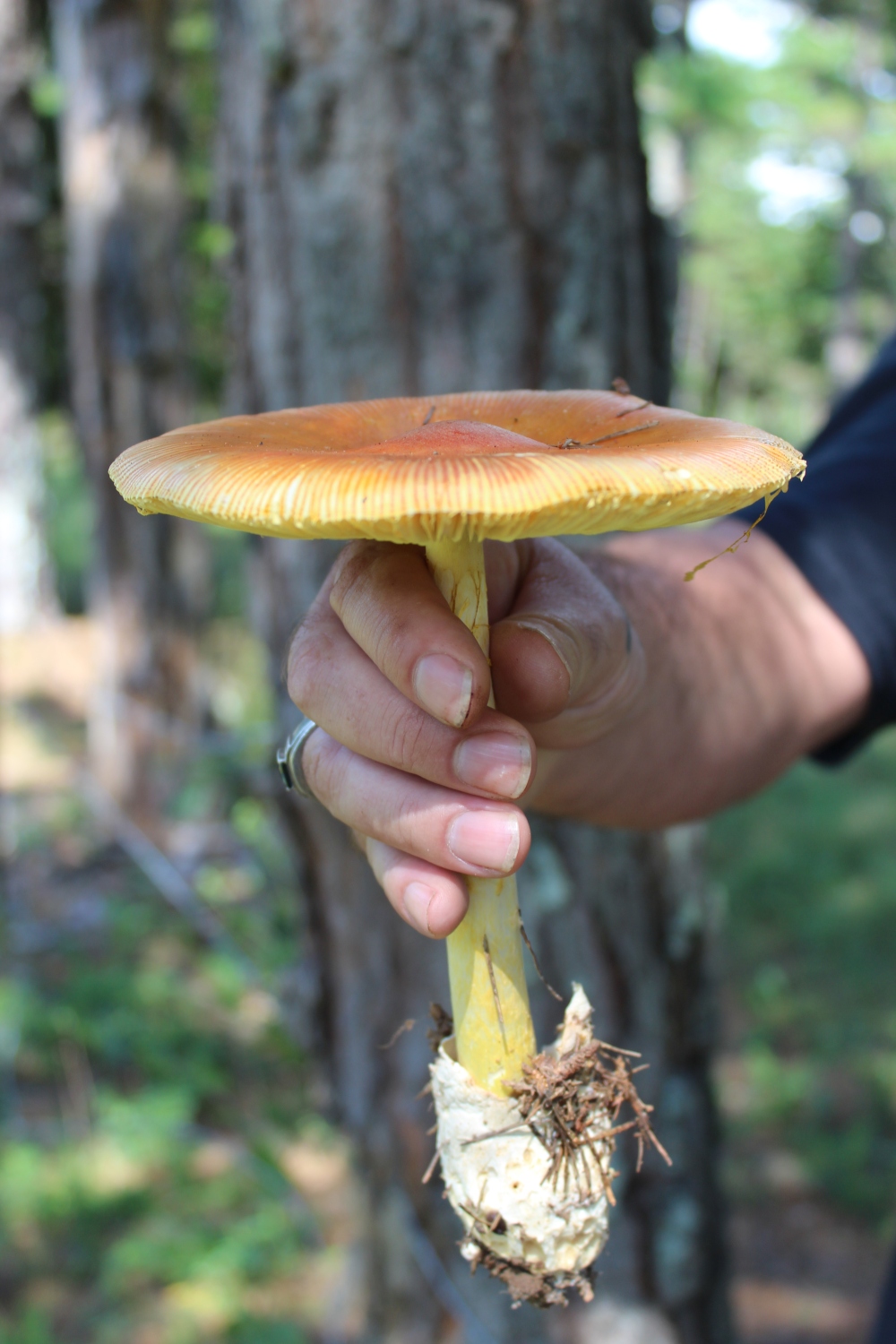
Amanita in egg sack.
A few weeks ago, we took a little weekend trip to rural Missouri and as we rounded a bend, we saw a lawn literally covered with what could only be amanitas.

Many had been mowed over by a lawn mower, but they all had the distinctive “egg sack” and ring that is a remnant of a partial veil that covered the gills in early developmental stages. On the whole, I love photographing Amanitas because they are so damned beautiful.
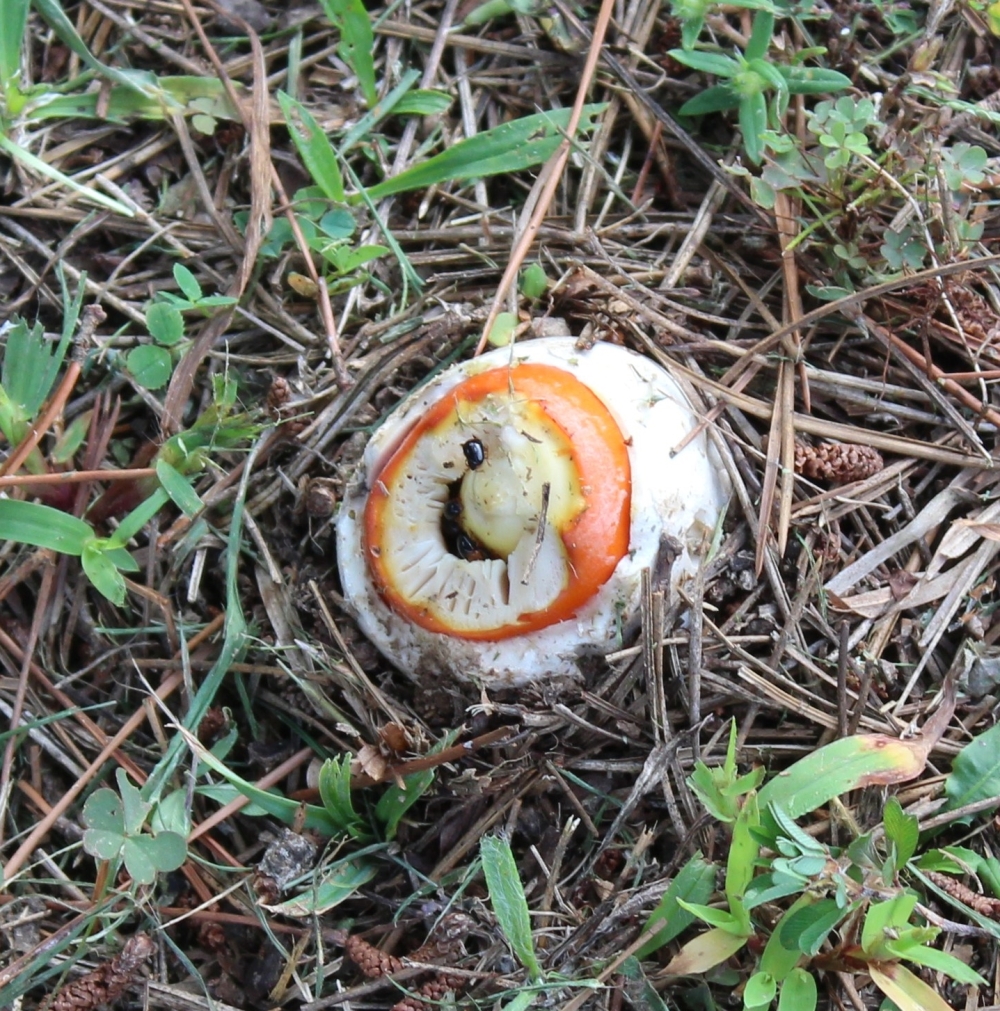
Amanita egg that got mowed.
We hadn’t planned on mushroom hunting, and had no books, identification devices, collection tools, or cell service. Great. We got permission and collected everything we could find that hadn’t been whacked by a lawn mower. We put them in our cooler, loose, and hoped for the best.

Amanita caps placed on a black surface to spore print.
When we finally got to our hotel, (knowing that the spore print of the Amanita jacksonii is white) we improvised by doing the spore print on the inside cover of the hotel binder. We woke up the next morning to white spore prints as we suspected there would be.

Spore prints left on the inside of a binder. Amanita jacksonii leaves white spores.
I photographed them from every angle possible, and by hook and crook got them chopped and cooked. As suspected, they tasted like fine French cheese. We didn’t eat a whole lot, mostly just tasted because honestly… who eats a bowl of mushrooms by itself? We were interested in preserving them so they wouldn’t turn.
After we cooked them (and I wiped all the spores out of the binder) we spent the day enjoying the outdoors. Out of the blue, I got some cell signal back and sent the below photo (which is not even a diagnostic one, it is more of a glamor shot I took for Instagram) to one of our mycology friends whom we had previously discussed our interest in Amanitas with, Jay Justice, co-author of “Amanitas of North America” that I have written about another time.
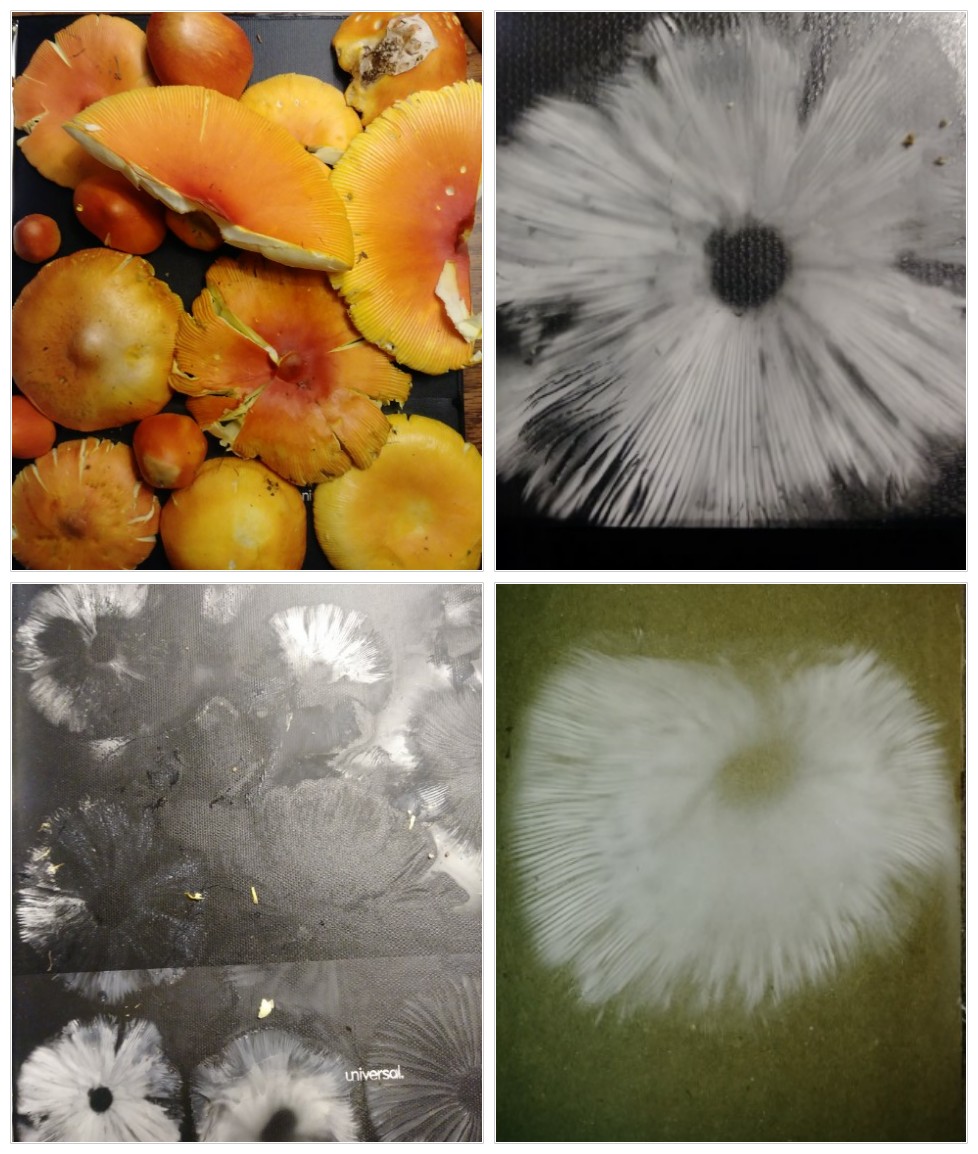
Amanita spore print collage. The bottom right is the inside cover of my husbands journal and was clear coated to preserve it.
We again went about our business and then several hours later my phone blew up when I got signal again. Amidst all the various notifications, was an email back from Jay telling me that they were NOT in fact Amanita jacksonii, but a very closely related (and still edible) member of the family that doesn’t even have a name at this point. He sent a link and suggested we check out the alpha numeric listing of Amanita sp-AR01. That link clearly defines the temporarily named species as distinct with the coloration of the cap and stipe, which are subtle enough that the range is probably much greater than the current confirmed range. We found it about 120 miles outside it’s current known range. Most members of this species are being misidentified and it sure is a good thing they are edible too.
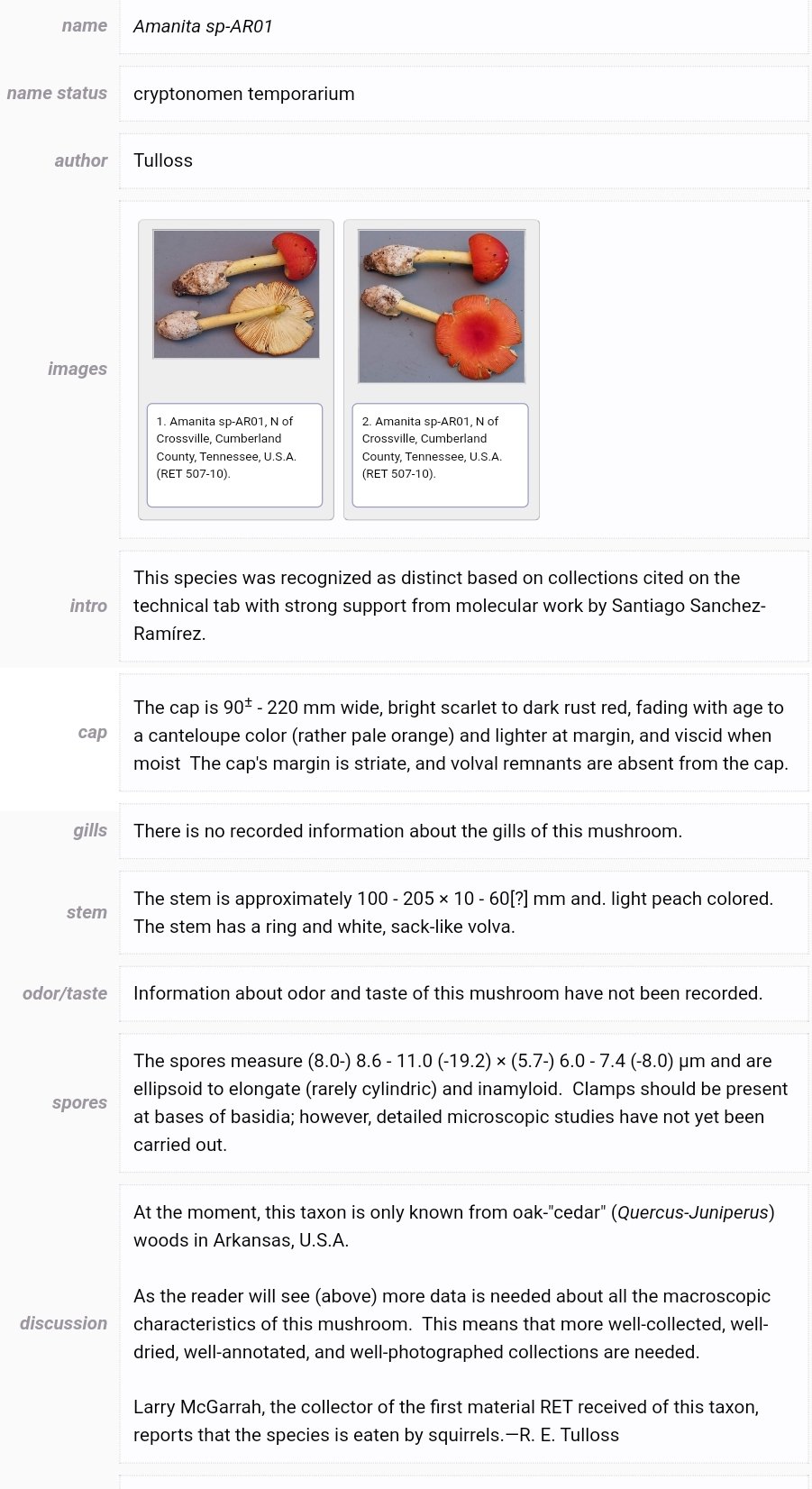
Jay was absolutely correct even though I had not sent a decent diagnostic photo. That man constantly amazes me with his mycological knowledge. Good thing we hadn’t been utterly WRONG, they were still edible, and we knew an expert. Very, very close call.
This brings up an important factor in identification. I have seen many articles that claim that A. jacksonii have a fishy smell/taste and others that say, no, it tastes like cheese. Aside from the subjective nature of the senses, there is also the factor that many, many, MANY people are misidentifying members of the Stirps hemibapha as A. jacksonii and attributing the scents and flavors of the various Stirps Hemibapha species as A. Jacksonii. Hence the discrepancy.
The kind we had for sure tasted like baked brie. Some of the other species smell and taste fishy, but they aren’t in fact A. jacksonii, just closely related species. That’s how easy it is to misidentify a mushroom if you aren’t keyed into some very minute and discrete details like a professional mycologist.
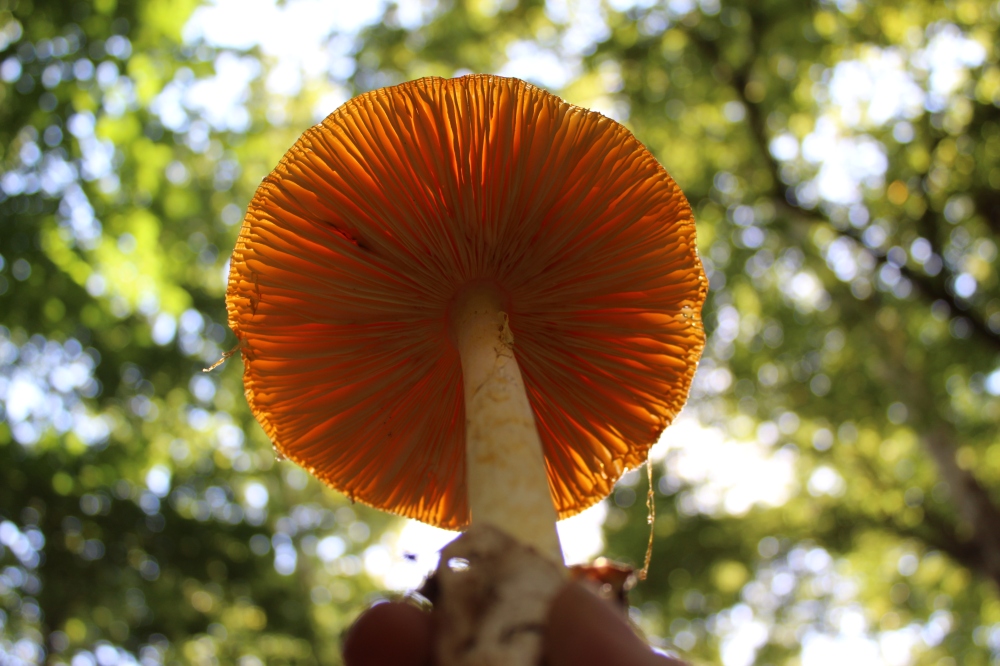
Genetic testing is turning the biological world on its head in many ways, but very much so in the mycological world. The most obvious example I can think of is Ganoderma lucidum, also known as reishi, or Ling Chi. This is a mushroom that has legitimate medicinal qualities. So imagine the surprise when it turns out that genetically, the mushroom that looks identical in North America and Asia is not in fact Ganoderma lucidum in North America? It is not only NOT G. lucindium, it is two separate and distinct, discrete species in NA; Ganoderma curtisii and Ganoderma tsugae. Minds blown everywhere.
It turns out that Amanita jacksonii is one of those taxa that is currently being redefined by genetic testing. I wish we had known. If we had, we could have properly collected samples when we were out in the field. We could have helped expand the known range and provided other valuable data. Lesson learned.
The lessons we learned from this are:
- Always take your books, even if you aren’t planning on identifying anything.
- Always properly collect and preserve a representational sample.
- Don’t eat anything in the risky category until you have verification from someone that actually knows something.
- SCIENCE DOESN’T STOP BECAUSE YOU ARE ON A WEEKEND!
Use caution, get good resources, do lots of research, join a mycological society near you, take classes, and take lots of photos. Mushrooms are so ephemeral; they can be at their prime in the morning and a patch of slimy goo that evening. Enjoy their beauty, their strange forms, and know that they won’t be around for very long.
Even if this was not the Amanita jacksonii my husband was looking for, there is no denying it made him very happy to find it. He loves Amanitas and has considered getting another degree, this time in Mycology. I think the Amanitas made his weekend more than anything else.
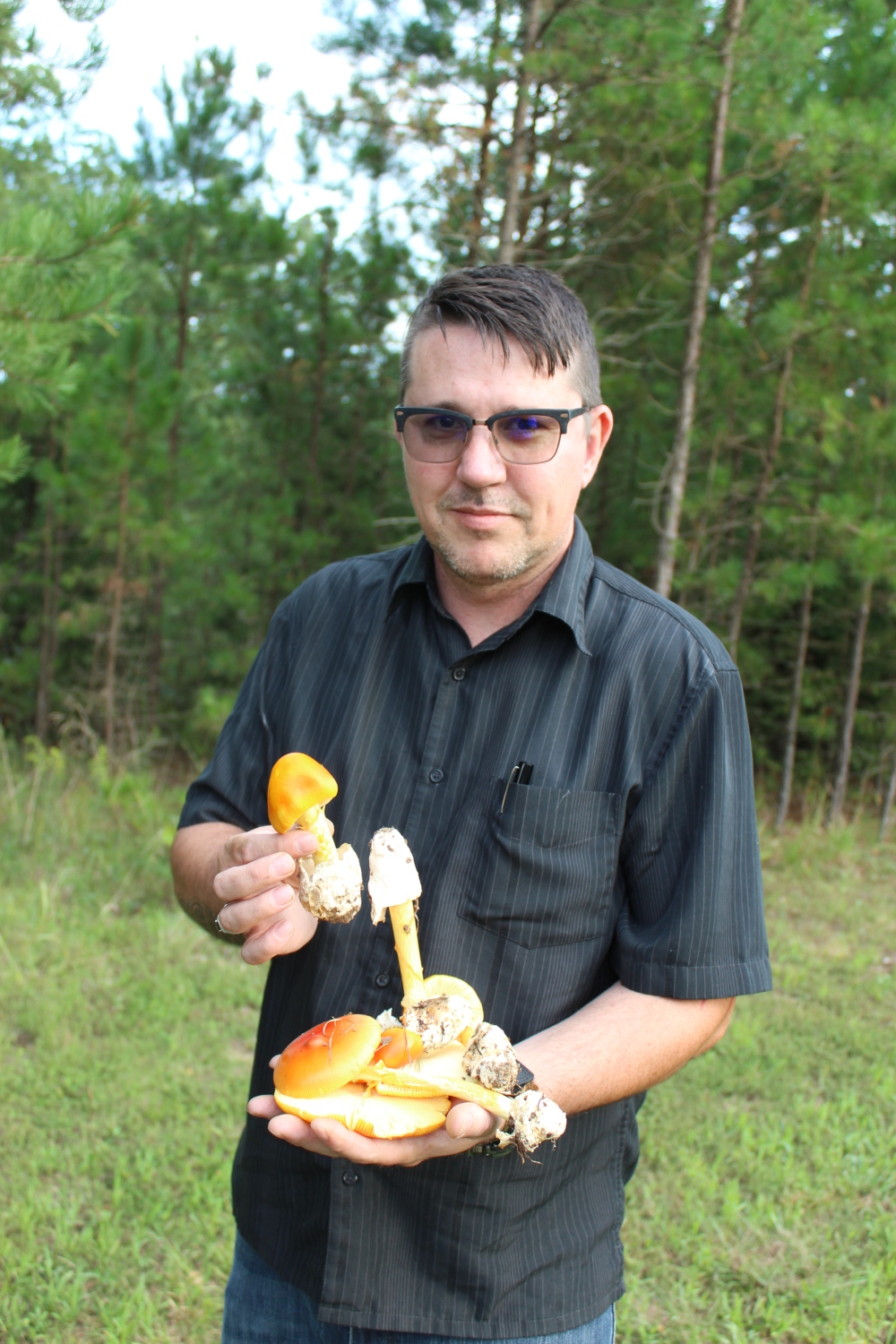
Doesn’t my husband look so happy? Happy hunting and stay safe out there!
I strongly recommend buying the Amanitas of North of America book by Britt Bunyard and Jay Justice if you are interested in amanitas. You can buy it here:google books or through Fungi Magazine which has all sorts of great things, and the magazine is a phenomenon resource. Britt Bunyard is really personable and the magazine is a treasure trove of information.
Or you can use the link in my post about the book. I have a copy, and it is amazing!

This solves a mystery for us. It looks and sounds like this is the variety we have in abundance in our woods in Maryville, Tennessee. They smelled really delish and it was frustrating to watch the critters munching them up and not to join them (out of caution.) Thanks for posting this.
LikeLike
So what was the determining factor that your friend used to say they weren’t what you thought they were?
LikeLike
The striations on the margin of the cap, the color being orange fading to a cantaloupe, the stipe color/threads peeling off of it, and the nipple like spot on the cap.
He said that in fairness, many people have probably been identifying the various look alikes as jacksonii since the details are so minute, but he’s a mycologist so it was obvious to him.
LikeLike
I have Amanita jacksonii growing on my land in NC. If i could post a photo I would. Myles
LikeLike
Lucky you! Do you eat them?
LikeLike